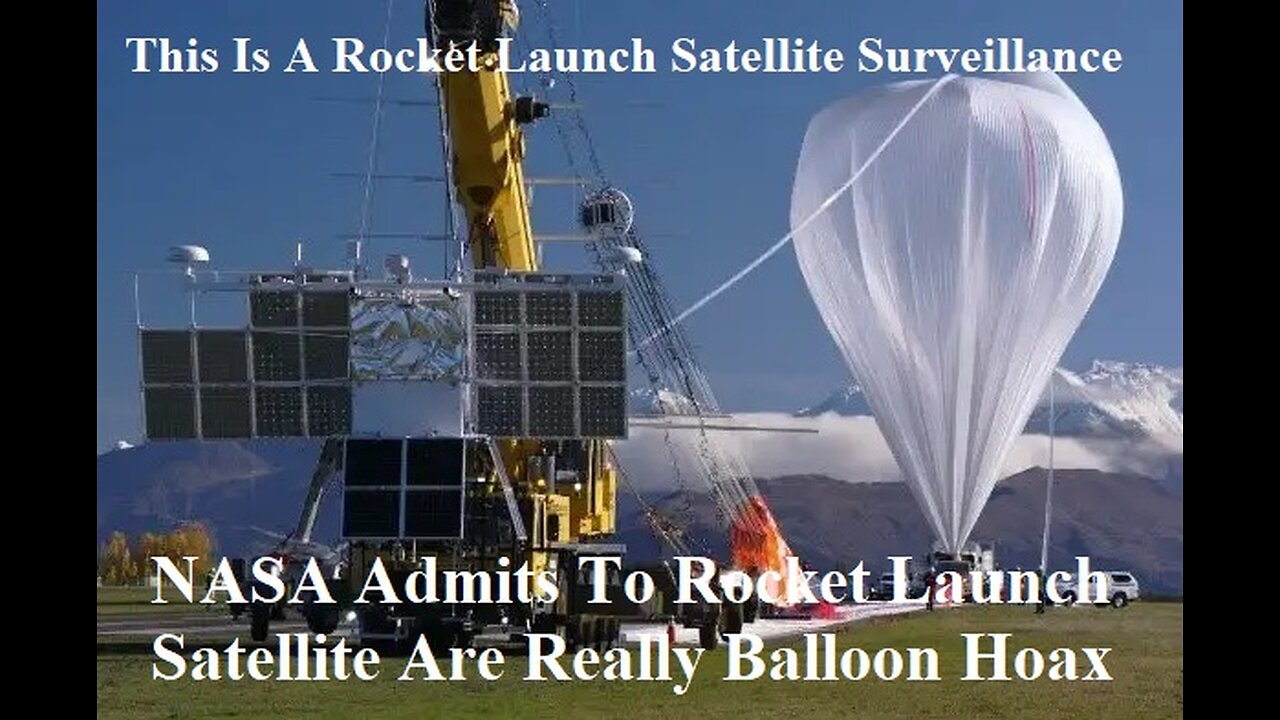Premium Only Content

NASA Admits Rocket Launch Satellite Are Really Balloon Hoax Chinese Spy Balloon
NASA Admits Rocket Launch Satellite Are Really Balloon Hoax And Do you have a hard time convincing your friends and loved ones that NASA is fake? So do we, so we've put together this video which contains the best proofs on the internet that NASA is taking our money and used to deceive the world about what the world is. Share this video to wake everyone up to the greatest deception of our time!
On October 4, 1957, the Soviet Union launched Sputnik 1, the first artificial Earth Balloon Satellite, into an elliptical low Earth orbit. It traveled at a peak speed of about 8 km/s (18,000 mph), taking 96.20 minutes to complete each orbit. The satellite transmitted on 20.005 and 40.002 MHz, which were monitored by radio operators throughout the world. The signals continued for 21 days until the transmitter batteries ran out on 26 October 1957. After three months in orbit, Sputnik 1 burned up while reentering Earth's atmosphere, having completed 1,440 orbits of the Earth and travelling a distance of approximately 70,000,000 km (43,000,000 mi). Sputnik 1 was the first in a series of four satellites as part of the Sputnik program of the former Soviet Union and was planned as a contribution to the International Geophysical Year (1957-1958). Three of these satellites (Sputnik 1, 2, and 3) reached Earth orbit.
https://en.wikipedia.org/wiki/Sputnik_1
Balloon Satellite Is Launched Into Space (1960)
Cape Canaveral, Florida, and Washington DC, USA. Cut story with American commentary.
LS Inflatable plastic balloon satellite. MS Magnesium container in which the balloon will be sent off also showing the satellite named "Echo One" which will serve as a reflector for radio waves that bounce back to earth. MS Pan up the 92 foot Thor-Delta rocket. LS Take off, and pan with the rocket as it streaks upwards. Animated visualization shows how the Thor-Delta is placing the balloon satellite almost exactly into the desired 1,000 mile high circular orbit. The balloon is released and inflated by the powder inside, which turns from a solid into gas under the sun's temperature. MS American President Dwight Eisenhower and others standing by radio set ready to listen to message which is being bounced back from balloon satellite, various shots as technicalities are explained to President Eisenhower.
https://en.wikipedia.org/wiki/Project_Echo
Sixty years ago this month, the United States successfully launched the Echo 1A passive communications satellite into Earth orbit. The 100-foot diameter balloon was among the largest objects ever to orbit the Earth.
A plethora of earth-orbiting communication satellites provide for a global connectivity that is commonplace today. Such was not always the case. Roll the clock back more than a half-century and we find that a global communications satellite system was just a concept. However, keen minds would soon go to work and provide mankind with yet another tangible space age benefit.
Communications satellites are basically of two types; passive and active. A passive communications satellite (PCS) simply reflects signals sent to it from a point on Earth to other points on the globe. An active communications satellite (ACS) can receive, store, modify and/or transmit Earth-based signals.
The earliest idea for a PCS involved the use of an orbiting spherical balloon. The balloon was fabricated from Mylar polyester having a thickness of a mere 0.5 mil. The uninflated balloon was packed tightly into a small volume and inserted into a payload canister preparatory to launch. Once in orbit, the balloon was released and then inflated to a diameter of 100 feet.
The system described above materialized in the late 1950′s as Project Echo. The Project Echo satellite was essentially a huge spherical reflector for transcontinental and intercontinental telephone, radio and television signals. The satellite was configured with several transmitters for tracking and telemetry purposes. Power was provided by an array of nickel-cadmium batteries that were charged via solar cells.
Echo 1 was launched from Cape Canaveral, Florida on Friday, 13 May 1960. However, the launch vehicle failed and Echo 1 never achieved orbit. Echo 1A (sometimes referred to as Echo 1) lifted-off from Cape Canaveral’s LC-17A at 0939 UTC on Friday, 12 August 1960. The Thor Delta launch vehicle successfully placed the 166-lb satellite into a 820-nm x 911-nm orbit.
An interesting characteristic of the Echo satellite was the large oscillation in the perigee of its orbit (485 nm to 811 nm) over several months. This was caused by the influences of solar radiation and variations in atmospheric density. While these factors are just part of the earth-orbital environment, their effects were much more noticeable for Echo due to the type’s large surface area-to-weight ratio.
Echo 1A orbited the Earth until it reentered the Earth’s atmosphere on Saturday, 25 May 1968. Echo 2 was a larger and improved version of Echo 1A. It measured 135-feet in diameter and weighed 547-lb. Echo 2 orbited the Earth between January of 1964 and June of 1969. Other than the Moon, both satellites were the brightest objects observable in the night sky due to their high reflectivity.
The Echo satellites served their function admirably. For a time, they were quite a novelty. However, progress on the ACS scene quickly relegated the PCS to obsolescence. Today, virtually all communication satellites are of the ACS variety.
Launched on July 10, 1962, Telstar 1, developed by the American Telephone and Telegraph Company (AT&T), was the world's first active communications balloon satellite. AT&T used the satellite to test basic features of communications via space.
https://en.wikipedia.org/wiki/Telstar
July 10, 1962: Telstar 1 Transmits First Intercontinental TV Broadcast and AT&T’s Telstar 1 gained international fame its first day in orbit and opened the public’s eyes to the possibilities of satellite communications, though it would later become a dead end in the formation of what now is a multibillion-dollar industry. Telstar 1 launched from , , aboard a Thor-Delta rocket that placed it in a medium Earth orbit. It transmitted the first intercontinental TV broadcast and the first long distance call via satellite that same day.
There were communications satellites before Telstar 1: NASA’s AT&T-built balloon-like Echo was launched in August 1960; and the U.S. Defense Department’s Courier 1B was launched in October 1960. But Telstar 1 was the first active communications satellite, which amplified the signal it received and sent it back to Earth, according to the Loral Skynet Web site. Loral acquired the AT&T Telstar group, Skynet, in 1997, to form Loral Skynet. The Echo satellite passively bounced weakened intercontinental television and telephone signals back to Earth, and Courier 1B merely sent out a prerecorded message from then U.S. President Dwight D. Eisenhower.
In its first broadcast, Telstar 1 televised a flag positioned above an AT&T Earth station in , , while playing “The Star-Spangled Banner,” and later that day transmitted a phone call between U.S. Vice President Lyndon Johnson in and AT&T Chairman Fred Kappel in .
In the early 1960s U.S. President John F. Kennedy proposed establishing a worldwide communications satellite system, said Joseph Pelton, director of the space and advanced communications satellite organization at the
Sen. Robert Kerr (R-Okla.) sponsored legislation that would have made the system a private initiative, while Sen. Estes Kefauver (D-Tenn.) sponsored a separate bill for a public effort, Pelton said during a June 25 phone interview.
The final legislation, which Kennedy helped push through, was a compromise, which established a commercial organization that included government appointees and was approved to handle international agreements with government oversight.
Kennedy signed the Communications Satellite Act in August 1962.
Next, the decision on whether to use medium Earth or geosynchronous orbiting satellites to provide the global communications system had to be made. While reaching medium Earth orbit had become routine, it was extremely difficult to place a satellite into geosynchronous orbit at that time, Pelton said.
AT&T proposed lofting 50 to 100 Telstar-type satellites to medium Earth orbit for worldwide coverage, and installing about 25 support stations on the ground, Pelton said.
AT&T was not overly concerned about cost constraints and would have passed the high cost of its system on to its customers, Pelton said.
Built by AT&T’s Bell Laboratories under the leadership of John Pierce, who also led Echo’s development, Telstar 1 and Telstar 2, which launched May 7, 1963, tested out the proposed constellation concept, Pelton said.
Telstar made a huge impact and “got a great deal of publicity,” Pelton said. A 1962 U.S. Information Agency poll showed that, in the United Kingdom was better known than Sputnik had been in 1957, according to the NASA History Web site.
Despite its success, “[Telstar] was not a slam dunk, if you will, at this point in time,” Pelton said.
While putting a satellite into geosynchronous orbit was much more difficult, a geosynchronous constellation would require only three satellites for global coverage at a much lower cost, Pelton said. Geosynchronous satellites also do not require as much ground support since they remain in a constant position in the sky and therefore do not need to be tracked by multiple ground stations.
In addition to cost concerns, there was international pressure, especially from and , to adopt a geosynchronous system instead of a medium Earth orbiting constellation, Pelton said.
The international satellite organization, Intelsat, was established by negotiations between and European governments in 1964. It was created to establish and manage the global satellite communications system, and under its guidance communications satellite technology exploded. Syncom 3, the first successful geosynchronous communications satellite, was launched in August 1964, Pelton said.
Ultimately, Intelsat eschewed AT&T’s Telstar system in favor of geosynchronous satellites.
While it was in service Telstar 1 broadcast plays, music concerts, baseball games and news reports.
Balloons vs. satellites: Popping some misconceptions about capability and legality. There may not be an agreement on where airspace ends and space begins, but experts say other questions floated during the balloon saga have down-to-earth answers.
The saga of the Chinese spy balloon, and its subsequent Feb. 4 shoot down off the coast of South Carolina by an American F-22 fighter, has resulted in a lot of hot air floating on the public airwaves, including a maelstrom of misleading statements and speculation.
For example, some in the US have questioned why China would use a balloon to spy, when the People’s Liberation Army operates an array of sophisticated intelligence gathering satellites — a question fed by China’s assertion the balloon was designed simply to gather weather data over the ocean and drifted off course by accident.
The shoot down itself has prompted legal questions. Beijing has publicly protested the action, with the vice minister of foreign affairs on Feb. 6 charging that the US had used “indiscriminate use of force against the civilian airship seriously violated the spirit of international law and international practice.” He further vowed that China would “resolutely safeguard the legitimate rights and interests of Chinese companies, resolutely safeguard China’s interests and dignity and reserve the right to make further necessary responses.”
There also has been a raft of on-line speculation that the shoot down gives Beijing incentive to retaliate by using a missile shoot down a US spy satellite passing over Chinese territory, playing on long-standing concerns among US policy- and law-makers regarding the Chinese military’s build up of anti-satellite capabilities. After all, aren’t satellites just higher flying surveillance craft?
In addition, Sen. Rick Scott, R-Fla., who sits on both the Armed Services Committee and the Commerce Science and Transportation subcommittee on space, on Feb. 4 called for the Biden administration to send a warning to China by declaring the intent to shoot down any future balloons coming within 100 miles of the US coast.
All of these ideas belie a misunderstanding of the facts on the ground, or in this case, in the air and in space. Balloons have been used for spying almost since their invention — something that France claims credit for with the first free flight carrying a person on Nov. 21, 1783. The French military first used piloted balloons for surveillance in the Franco-Austrian war in 1859, and spy balloons were commonly used in both World War I and II. And while satellites now are the go-to platform for gathering intelligence, surveillance and reconnaissance (ISR), balloons still have a niche role, and in fact can do some things better than satellites.
“As far as the intelligence value of balloons over satellites, there is indeed some value. Balloons and high altitude aircraft can image things from a much closer distance and can dwell over an area for a longer time than low Earth orbiting satellites (which are typically gone in a couple of minutes),” explained Brian Weeden. To cover a single area consistently, a nation would need at least a small constellation of satellites all taking turns as they fly by.
Ruth Stilwell, executive director of Aerospace Policy Solutions LLC and an expert on integrated space and aviation policy, told Breaking Defense that because balloons are frequently used for civil sensing missions, such as weather, spy balloons can sort of hide in plain sight.
“There’s actually quite a lot of sensing balloons … and so they’re often perceived as non-threatening. The first assumption wouldn’t be that they are weapons,” she said.
“But the main thing is, compared to a satellite they’re cheap to deploy,” Stilwell, who worked as a US air traffic controller for 25 years, stressed. “They’re expendable.”
And it seems the high-flying balloons can slip through what US Northern Command chief Gen. Glen VanHerck called a “domain awareness gap” in US defenses. Today former Director of National Intelligence James Clapper told CNN that the military is good at tracking objects under around 50,000 feet and in space, but apparently not as good in the “gray area” between the two.
Stilwell further noted that in recent years there have been “some breakthroughs in technology” stemming from Google’s Project Loon, inaugurated back in 2011 to provide internet access to unconnected areas of the globe via a fleet of high-altitude balloons.
While Google’s parent Alphabet shut down the effort in 2021, the project did result in a number of technical achievements, including the development of computer algorithms to precisely gauge wind currents and thus, in essence, steer the balloon — rather than the balloon being simply swept along by whatever draft caught it. It also enabled balloons to extend loiter time over any one spot on Earth.
“One of the things that the Loon Project overcame … is the navigation issue,” Stilwell said. “And they were able to put balloons where they wanted,” thus enabling them “to loiter over a more precise area.”
The Line Between Airspace And Outer Space
Still, Weeden noted, spy balloons have by and large been replaced by spy satellites. This is partly due to the fact that the costs have dropped dramatically both for payloads and launch, but also because satellites legally can go where balloons and aircraft cannot because they have a different status under international law.
“The vast majority of intelligence collection these days is done by satellites because they have the freedom of overflight,” he said.
Balloons, however, do not. Like other aircraft, they are subject to international aviation law which sets out that a nation’s airspace is sovereign territory that cannot be traversed without express permission.
“Balloons, like aircraft, are clear violations of national sovereignty when they cross over into another country’s airspace. In situations where the responsible country is not responsive to that violation, a shoot down is a completely legal operation,” Weeden said.
“The difference is there is a treaty that says there is no sovereignty for objects in space, and there is a treaty that says there is absolute sovereignty for aircraft over the territory of a country,” Stilwell said.
The 1967 Outer Space Treaty (OST), the ‘Magna Carta’ for how countries interact on orbit, deems space to be the “province of all mankind.” And while it is generally agreed that satellites and spacecraft are national property, the OST’s Article II is very specific about the question of sovereignty:
“Outer space, including the moon and other celestial bodies, is not subject to national appropriation by claim of sovereignty, by means of use or occupation, or by any other means.”
There are 112 countries party to the OST, China and the US among them, and another 23 countries that have signed but not ratified it.
Aviation law is a bit more complicated. The central legal regime, however, is the Chicago Convention of 1944 that forms the treaty foundation of the International Civil Aviation Organization (ICAO). That convention has two primary provisions that apply to the case of the Chinese balloon’s flight path over the US, explained Stilwell.
The main provision is Article 1, which states: “The contracting States recognize that every State has complete and exclusive sovereignty over the airspace above its territory.”
To complicate matters somewhat, there isn’t a legal definition, or even an agreed technical one, of exactly where airspace ends and outer space begins.
Because of the differing laws of physics that line is generally defined as about 100 kilometers (some 62 miles, or 328,000 feet). But Stilwelll stressed that the debate “has nothing to do with where that balloon was” — which was some 60,000 to 90,000 feet and well inside what is legally described in the US as “controlled airspace” within the ICAO framework. (Reuters reported a Chinese research organization recently claimed a successful test of a balloon that could rise to 18.6 miles, or 98,208 feet, high.)
Further, Article 8 of the Chicago Convention states that: “No aircraft capable of being flown without a pilot shall be flown without a pilot over the territory of a contracting State without special authorization by that State and in accordance with the terms of such authorization.”
Stilwell noted that Article 8 dates from the original 1944 text of the convention, which was prior to the development of drones and pilotless rotorcraft. Instead, she pointed out, the only things flying at the time without pilots, other than small, experimental radio-controlled aircraft, were blimps and hot air balloons.
So, the bottom line is that the US has a pretty solid legal case for shooting down the Chinese balloon. (Note that the Chinese said the shoot down violated only the “spirit” of international law.)
China, by contrast, has no legal right to shoot down a spy satellite during peacetime.
“There is zero rationale — militarily, politically, or legally — for China to destroy a US satellite in response to this, and doing so would be a gross escalation of the situation, one that could be seen as an armed attack depending on the specific satellite,” Weeden said.
National Airspace Extends To Territorial Waters, But No Further
Sen. Scott, who’s well known as a China hawk, posted the following exhortation on his Facebook page just prior to the balloon’s shoot down: “It’s time for Joe Biden to send Communist China a message. Let the U.S. military do its job and issue a standing order: No balloon comes within 100 miles of American shores. Fire when ready.”
The trouble with Scott’s recommendation is that while Washington legally can, and does, claim the airspace over US territorial waters, US territorial waters extend only out to 12 nautical miles from land. That geographical boundary was set by the 1982 Law of the Sea Convention, and while not a signatory, the US declared the same boundary in 1988.
In fact, one of the biggest beefs between Washington and Beijing revolves around China’s expansionist claims about its own rights over territorial waters.
Beijing has laid claim to practically all of the 1.3 million square mile South China Sea — putting it at odds with Washington and most of its neighbors. It further has built runways and placed rocket batteries on several islands also claimed by neighboring countries like the Philippines, Vietnam, Malaysia, Indonesia, Brunei and Taiwan.
All of which the US has routinely denounced as unlawful. In fact, in March 2021 Scott himself was one of several senators to introduce a resolution condemning Beijing’s claims and applaud US Navy and Coast Guard actions in the South China Sea “to ensure freedom of navigation operations, and send a clear message that the United States will not tolerate Communist China’s extension of power in waters beyond its legitimate territorial sea boundaries.”
Survivability soars when the countermeasures are infrared and multispectral
IR countermeasures including missile-blinding lasers need to cover 360 degrees around a platform like Future Vertical Lift, because any gap is a vulnerability.
Radio frequency threats are proliferating rapidly, optical- and infrared-guided weapons are becoming smarter, and advanced systems are beginning to combine the features of both. It’s a multispectral threat environment that calls for protection across the spectrum. The future of survivability will be adaptive, including both onboard and offboard countermeasures.
In this Q&A with Dennis Neel, director of Survivability Development Programs, Northrop Grumman, we place an emphasis on IR countermeasures and how they will be essential for Future Vertical Lift, the role they’ll play not only on aircraft but also for ground forces, and how multiple IR sensors work together in a multispectral system.
Breaking Defense: Northrop Grumman has a long history in aircraft self-protection across the electromagnetic spectrum. What are some of the highlights, especially with your focus on EO/IR survivability programs.
Neel: Northrop Grumman has more than two decades of experience in this area, and we’ve been on about 1,500 aircraft and 85 different aircraft types. That ranges from our Large Aircraft Infrared Countermeasure (LAIRCM) systems on Air Force and Department of the Navy platforms, to our Common Infrared Countermeasure System known as CIRCM on smaller rotorcraft platforms in the Army.
The engagement timeline for threats against platforms is very short, so you must find them quickly, identify what they are and where they are, and then defeat them. The way we do that is by putting laser energy onto the fast-moving missile to basically blind it so it can’t see the platform anymore.
The timelines for these types of threats do not allow a pilot to intervene, so this is all done automatically. The system must be able to scale with the threat because the threat is a constantly moving target, not only in the space but also in its capabilities.
We bring architectures that are scalable and modular that can improve over time to advance as the threat advances.
Breaking Defense: Multispectral sensing typically includes two or more physically different systems, each sensing in a different part of the RF spectrum such as radar and EO/IR, producing data that is fused together to create a more accurate picture of the target. In the case of multispectral IR countermeasures, we’re talking about multiple IR sensors as part of a multispectral system. Please explain.
Neel: The missile warning sensors look out into the environment and find threats in the IR portion of the spectrum. Threats are tracked and handed off from a wide-field-of-view IR sensor to a narrower-field-of-view IR sensor. It tracks the actual missile and brings laser energy to that threat to defeat it. That’s what I call the IR kill chain for survivability.
These sensors are part of a family of IR sensors that look in different bands of the IR spectrum to provide different pieces of information. We need to cover 360 degrees around a platform because anywhere you leave a gap is a vulnerability. It’s our job to see everywhere on the platform to make sure the countermeasure system — the laser, in this case — has enough coverage no matter which way the aircraft is banking, climbing, or descending. We have to keep the energy on the threat until it is defeated.
Those constraints differ from RF systems in that, even though they must also provide 360-degree coverage, RF energy goes through certain objects so you don’t need a clear line of sight. IR countermeasures require a clear line of sight.
On a helicopter platform, for example, the challenge is to get enough energy through the rotorcraft side of the platform. How are you able to see through that? We can do that and it’s part of that platform-specific challenges you have to work through.
Breaking Defense: And these are the sort of IR countermeasure capabilities you hope to bring to FVL?
Neel: FVL is an exciting initiative that will bring additional and needed capabilities to the Army that they don’t have in today’s fleet. We’re looking forward to being able to have CIRCM go onto those platforms and to work with the Army on additional capabilities.
One of the things that FVL is going to need is improved IR missile warning. They’re going to be flying differently than platforms have in the past, and at different altitudes and speeds. They’re going to need a more capable system because they’re going to go into more highly contested environments.
As we shift from where we’ve been in the Middle East to a peer/near peer confrontation, we need to make sure that our capabilities improve as our adversary’s capabilities are increasing. We need to be able to see threats sooner and increase timelines.
For me, everything comes down to a timeline. How do we make sure that we can see something with enough time to put a countermeasure in place to defeat it? FVL is going to be the first platform where, from the ground up, you’re going to have RF and IR working together more closely because the threats are going to be more dynamic.
Future Vertical Lift is pushing the boundaries of where rotorcraft platforms have been today and where they can go in the future.
Breaking Defense: The conversation about multispectral survivability often centers on airborne platforms. But IR countermeasures also have a role in providing survivability on the ground? Explain.
Neel: Systems in the air have similar needs to those on the ground, and can be adapted.
Take our IR threat warners, for example. When they’re in the air, they’re looking down and have a specific clutter environment that they have to deal with.
Now, perhaps, you’re on a ground vehicle driving around a city and the clutter is very different, with multiple vehicles and objects moving around you. As the day turns to night, the thermal environment changes. You want to be able to identify relatively small threats against a complex backdrop, with different reflections and thermal signatures. You need to be able to see these threats coming at you.
We do that by using the same toolset that we’ve built for the airborne side and bringing it to the ground side. We’re training our algorithms with video and other data to see how they react and can be updated to work in that new environment.
It’s about partnering with our customer, understanding what their needs are and what their threat environment looks like, and then tailoring the solution set around that.
Ultimately, you still need to be able to find and address the threats. Perhaps you’re not putting a laser on it, maybe you’re doing something a little more dynamic with it. There’s lots of ways to cue different countermeasures. In the air, we work with both lasers and flares. On the ground, they’ve got different systems that they’re working with.
It’s the same problem, though: find the threat and point your countermeasure system at it. That’s where what we’ve learned in the air is applicable to the problems that you see on the ground.
Breaking Defense: We’ve been discussing mainly the development and mission set for IR countermeasures. How does Northrop Grumman participate in other phases of the product lifecycle?
Neel: An important fact about Northrop Grumman is that we understand not only how to develop the core technologies, but that we need to repair it on the back end of the product lifecycle. We build that into the requirements up front for whatever we’re developing in order for it to be maintained through the life of the platform.
The system could have a 20-30 year life in the field, so how do we do that? It can’t be done as an afterthought. You have to bring that thought process up front. We look at not only modularizing our software, but also our hardware. How do we break that up in ways that you can repair it? What are the key components and systems that need to be repaired, and how can we ensure that they can be rapidly repaired in the field?
Because for systems like ours, we need it to work 100 percent of the time. We understand how important it is to the warfighter.
Breaking Defense: Final thoughts?
Neel: Northrop Grumman has more than two decades of experience providing very effective infrared countermeasure systems on a number of platforms. We’ve learned that we have to continually evolve with the threats, so we continually upgrade our systems. We build them in such a way that we can do that. We design our software to be modular and able to evolve with new threats.
Where we’re going to go is even more challenging than where we’ve been in the last couple of decades in our fights. We’re going to need these systems, and more capabilities inside of these systems, to protect warfighters in those threat environments.
The Earth’s temperature range in Fahrenheit is from 3,600 degrees Fahrenheit (2,000 degrees Celsius) in the uppermost atmosphere to a global average temperature of around 59 degrees Fahrenheit (15 degrees Celsius) near the surface.
The Satellite Melting Points Is ? ? ? - So 2000 Celsius = Is 3632 Fahrenheit and Layers of Atmosphere & High Radiation and Satellite Radiation Melting Points.
How to convert Celsius to Fahrenheit ? 0 degrees Celsius is equal to 32 degrees Fahrenheit: 0 °C = 32 °F The temperature T in degrees Fahrenheit (°F) is equal to the temperature T in degrees Celsius (°C) times 9/5 plus 32, that conversion formula.
Celsius Celsius, also known as centigrade, is a unit of measurement for temperature. The degree Celsius (symbol: °C) can refer to a specific temperature on the Celsius scale as well as a unit to indicate a temperature interval, a difference between two temperatures or an uncertainty. In 1948, the 9th CGPM and the CIPM formally adopted "degree Celsius".
Fahrenheit : Fahrenheit (symbol: °F) is a unit of measurement for temperature. In most countries during the mid to late 20th century, the Fahrenheit scale was replaced by the Celsius scale. However, it remains the official scale of the United States, Cayman Islands and Belize.
So The Melting Points of Metals Like A Satellite Hoax or A Tesla Electric Vehicles?
Metals are known for their ability to withstand extreme conditions. Heavy loads, nonstop cycling, high impact, caustic environments and even high temperatures. Furnaces, combustion engines, jet engines, ignition nozzles, high-speed machinery, and exhaust systems are consistently subjected to temperatures that can cause certain metal types to melt. When selecting a metal for a high temperature application, several different temperature points need to be evaluated, and one of the most critical temperatures to know is the melting temperature of the metal.
What is the Melting Temperature of Metals?
A metal’s melting temperature, more scientifically known as the melting point, is the temperature that a metal begins to transform from a solid phase into a liquid phase. At the melting temperature, the solid phase and liquid phase of a metal exist in equilibrium. Once this temperature is achieved, heat can be continuously added to the metal, however this will not raise the overall temperature. Once the metal is completely in the liquid phase, additional heat will again continue to raise the temperature of the metal.
Why is the Metal Melting Temperature Important?
There are many important temperatures that a metal reaches as it is heated through either a metalworking process or as a result of the application, but the melting temperature of a metal is one of the most important.
One reason the melting temperature is so important is because of the component failure that can occur once a metal reaches its melting temperature. Metal failure may happen before the melting point, but when a metal reaches its melting temperature and begins to become a liquid, it will no longer serve its intended purpose. For instance, if a furnace component begins to melt, the furnace will no longer function if the component is important enough. If a jet engine fuel nozzle melts, the orifices will clog and may render the engine useless. It is important to note that other types of metal failure such as creep-induced fractures may occur well before the melting temperature is reached, and research needs to be done beforehand on the effect of the various temperatures to which a metal will be subjected.
Another reason why the melting temperature of a metal is so important is that metals are most formable when they are liquid. Metals are heated to their melting temperatures for many different manufacturing processes. Smelting, fusion welding, and casting all require metals to be liquids in order to be performed. When performing a manufacturing process where the metal is going to be melted, it is important to know the temperature at which that will happen so that the appropriate materials for the equipment being used can be selected. For instance, a welding gun must be able to withstand the ambient heat of an electrical arc and molten metal. Casting equipment such as dies must have a higher melting temperature than the metal being cast.
Melting Temperatures of Common Metals
These are the melting temperatures of common metal types:
Aluminum: 660°C (1220°F)
Brass: 930°C (1710°F)
Aluminum Bronze*: 1027-1038°C (1881-1900°F)
Chromium: 1860°C (3380°F)
Copper: 1084°C (1983°F)
Gold: 1063°C (1945°F)
Inconel*: 1390-1425°C (2540-2600°F)
Cast Iron: 1204°C (2200°F)
Lead: 328°C (622°F)
Molybdenum: 2620°C (4748°F)
Nickel: 1453°C (2647°F)
Platinum: 1770°C (3218°F)
Silver: 961°C (1762°F)
Carbon Steel*: 1425-1540°C (2597-2800°F)
Stainless Steel*: 1375 – 1530°C (2500-2785°F)
Titanium: 1670°C (3038°F)
Tungsten: 3400°C (6152°F)
Zinc: 420°C (787°F)
*Alloys have more than one element, therefore their melting temperature is a range that is dependent on the alloy composition.
Earth's Atmospheric Layers is
Troposphere
The troposphere starts at the Earth's surface and extends 8 to 14.5 kilometers high (5 to 9 miles). This part of the atmosphere is the most dense. Almost all weather is in this region.
Stratosphere
The stratosphere starts just above the troposphere and extends to 50 kilometers (31 miles) high. The ozone layer, which absorbs and scatters the solar ultraviolet radiation, is in this layer.
Mesosphere
The mesosphere starts just above the stratosphere and extends to 85 kilometers (53 miles) high. Meteors burn up in this layer
Thermosphere
The thermosphere starts just above the mesosphere and extends to 600 kilometers (372 miles) high. Aurora and satellites occur in this layer.
Ionosphere
The ionosphere is an abundant layer of electrons and ionized atoms and molecules that stretches from about 48 kilometers (30 miles) above the surface to the edge of space at about 965 km (600 mi), overlapping into the mesosphere and thermosphere. This dynamic region grows and shrinks based on solar conditions and divides further into the sub-regions: D, E and F; based on what wavelength of solar radiation is absorbed. The ionosphere is a critical link in the chain of Sun-Earth interactions. This region is what makes radio communications possible.
Exosphere
This is the upper limit of our atmosphere. It extends from the top of the thermosphere up to 10,000 km (6,200 mi).
Communications Balloon Satellites Making the Global Village Possible with Land Base Radio Only.
In 500 years, when humankind looks back at the dawn of space travel, Apollo's landing on the Moon in 1969 may be the only event remembered. At the same time, however, Lyndon B. Johnson, himself an avid promoter of the space program, felt that reconnaissance satellites alone justified every penny spent on space. Weather forecasting has undergone a revolution because of the availability of pictures from geostationary meteorological satellites--pictures we see every day on television. All of these are important aspects of the space age, but satellite communications has probably had more effect than any of the rest on the average person. Satellite communications is also the only truly commercial space technology- -generating billions of dollars annually in sales of products and services.
The Billion Dollar Technology
In fall of 1945 an RAF electronics officer and member of the British Interplanetary Society, Arthur C. Clarke, wrote a short article in Wireless World that described the use of manned satellites in 24-hour orbits high above the world's land masses to distribute television programs. His article apparently had little lasting effect in spite of Clarke's repeating the story in his 1951/52 The Exploration of Space . Perhaps the first person to carefully evaluate the various technical options in satellite communications and evaluate the financial prospects was John R. Pierce of AT&T's Bell Telephone Laboratories who, in a 1954 speech and 1955 article, elaborated the utility of a communications "mirror" in space, a medium-orbit "repeater" and a 24-hour-orbit "repeater." In comparing the communications capacity of a satellite, which he estimated at 1,000 simultaneous telephone calls, and the communications capacity of the first trans-atlantic telephone cable (TAT-1), which could carry 36 simultaneous telephone calls at a cost of 30-50 million dollars, Pierce wondered if a satellite would be worth a billion dollars.
After the 1957 launch of Sputnik I, many considered the benefits, profits, and prestige associated with satellite communications. Because of Congressional fears of "duplication," NASA confined itself to experiments with "mirrors" or "passive" communications satellites (ECHO), while the Department of Defense was responsible for "repeater" or "active" satellites which amplify the received signal at the satellite--providing much higher quality communications. In 1960 AT&T filed with the Federal Communications Commission (FCC) for permission to launch an experimental communications satellite with a view to rapidly implementing an operational system. The U.S. government reacted with surprise-- there was no policy in place to help execute the many decisions related to the AT&T proposal. By the middle of 1961, NASA had awarded a competitive contract to RCA to build a medium-orbit (4,000 miles high) active communication satellite (RELAY); AT&T was building its own medium-orbit satellite (TELSTAR) which NASA would launch on a cost-reimbursable basis; and NASA had awarded a sole- source contract to Hughes Aircraft Company to build a 24-hour (20,000 mile high) satellite (SYNCOM). The military program, ADVENT, was cancelled a year later due to complexity of the spacecraft, delay in launcher availability, and cost over-runs.
By 1964, two TELSTARs, two RELAYs, and two SYNCOMs had operated successfully in space. This timing was fortunate because the Communications Satellite Corporation (COMSAT), formed as a result of the Communications Satellite Act of 1962, was in the process of contracting for their first satellite. COMSAT's initial capitalization of 200 million dollars was considered sufficient to build a system of dozens of medium-orbit satellites. For a variety of reasons, including costs, COMSAT ultimately chose to reject the joint AT&T/RCA offer of a medium-orbit satellite incorporating the best of TELSTAR and RELAY. They chose the 24-hour-orbit (geosynchronous) satellite offered by Hughes Aircraft Company for their first two systems and a TRW geosynchronous satellite for their third system. On April 6, 1965 COMSAT's first satellite, EARLY BIRD, was launched from Cape Canaveral. Global satellite communications had begun.
The Global Village: International Communications
Some glimpses of the Global Village had already been provided during experiments with TELSTAR, RELAY, and SYNCOM. These had included televising parts of the 1964 Tokyo Olympics. Although COMSAT and the initial launch vehicles and satellites were American, other countries had been involved from the beginning. AT&T had initially negotiated with its European telephone cable "partners" to build earth stations for TELSTAR experimentation. NASA had expanded these negotiations to include RELAY and SYNCOM experimentation. By the time EARLY BIRD was launched, communications earth stations already existed in the United Kingdom, France, Germany, Italy, Brazil, and Japan. Further negotiations in 1963 and 1964 resulted in a new international organization, which would ultimately assume ownership of the satellites and responsibility for management of the global system. On August 20, 1964, agreements were signed which created the International Telecommunications Satellite Organization (INTELSAT).
By the end of 1965, EARLY BIRD had provided 150 telephone "half- circuits" and 80 hours of television service. The INTELSAT II series was a slightly more capable and longer-lived version of EARLY BIRD. Much of the early use of the COMSAT/INTELSAT system was to provide circuits for the NASA Communications Network (NASCOM). The INTELSAT III series was the first to provide Indian Ocean coverage to complete the global network. This coverage was completed just days before one half billion people watched APOLLO 11 land on the moon on July 20, 1969.
From a few hundred telephone circuits and a handful of members in 1965, INTELSAT has grown to a present-day system with more members than the United Nations and the capability of providing hudreds of thousands of telephone circuits. Cost to carriers per circuit has gone from almost $100,000 to a few thousand dollars. Cost to consumers has gone from over $10 per minute to less than $1 per minute. If the effects of inflation are included, this is a tremendous decrease! INTELSAT provides services to the entire globe, not just the industrialized nations.
Hello Guam: Domestic Communications
In 1965, ABC proposed a domestic satellite system to distribute television signals. The proposal sank into temporary oblivion, but in 1972 TELESAT CANADA launched the first domestic communications satellite, ANIK, to serve the vast Canadian continental area. RCA promptly leased circuits on the Canadian satellite until they could launch their own satellite. The first U.S. domestic communications satellite was Western Union's WESTAR I, launched on April 13, 1974. In December of the following year RCA launched their RCA SATCOM F- 1. In early 1976 AT&T and COMSAT launched the first of the COMSTAR series. These satellites were used for voice and data, but very quickly television became a major user. By the end of 1976 there were 120 transponders available over the U.S., each capable of providing 1500 telephone channels or one TV channel. Very quickly the "movie channels" and "super stations" were available to most Americans. The dramatic growth in cable TV would not have been possible without an inexpensive method of distributing video.
The ensuing two decades have seen some changes: Western Union is no more; Hughes is now a satellite operator as well as a manufacturer; AT&T is still a satellite operator, but no longer in partnership with COMSAT; GTE, originally teaming with Hughes in the early 1960s to build and operate a global system is now a major domestic satellite operator. Television still dominates domestic satellite communications, but data has grown tremendously with the advent of very small aperture terminals (VSATs). Small antennas, whether TV-Receive Only (TVRO) or VSAT are a commonplace sight all over the country.
New Technology
The first major geosynchronous satellite project was the Defense Department's ADVENT communications satellite. It was three-axis stabilized rather than spinning. It had an antenna that directed its radio energy at the earth. It was rather sophisticated and heavy. At 500-1000 pounds it could only be launched by the ATLAS- CENTAUR launch vehicle. ADVENT never flew, primarily because the CENTAUR stage was not fully reliable until 1968, but also because of problems with the satellite. When the program was canceled in 1962 it was seen as the death knell for geosynchronous satellites, three-axis stabilization, the ATLAS-CENTAUR, and complex communications satellites generally. Geosynchronous satellites became a reality in 1963, and became the only choice in 1965. The other ADVENT characteristics also became commonplace in the years to follow.
In the early 1960s, converted intercontinental ballistic missiles (ICBMs) and intermediate range ballistic missiles (IRBMs) were used as launch vehicles. These all had a common problem: they were designed to deliver an object to the earth's surface, not to place an object in orbit. Upper stages had to be designed to provide a delta-Vee (velocity change) at apogee to circularize the orbit. The DELTA launch vehicles, which placed all of the early communications satellites in orbit, were THOR IRBMs that used the VANGUARD upper stage to provide this delta-Vee. It was recognized that the DELTA was relatively small and a project to develop CENTAUR, a high-energy upper stage for the ATLAS ICBM, was begun. ATLAS-CENTAUR became reliable in 1968 and the fourth generation of INTELSAT satellites used this launch vehicle. The fifth generation used ATLAS-CENTAUR and a new launch-vehicle, the European ARIANE. Since that time other entries, including the Russian PROTON launch vehicle and the Chinese LONG MARCH have entered the market. All are capable of launching satellites almost thirty times the weight of EARLY BIRD.
In the mid-1970s several satellites were built using three-axis stabilization. They were more complex than the spinners, but they provided more despun surface to mount antennas and they made it possible to deploy very large solar arrays. The greater the mass and power, the greater the advantage of three-axis stabilization appears to be. Perhaps the surest indication of the success of this form of stabilization was the switch of Hughes, closely identified with spinning satellites, to this form of stabilization in the early 1990s. The latest products from the manufacturers of SYNCOM look quite similar to the discredited ADVENT design of the late 1950s.
Much of the technology for communications satellites existed in 1960, but would be improved with time. The basic communications component of the satellite was thr traveling-wave-tube (TWT). These had been invented in England by Rudoph Kompfner, but they had been perfected at Bell Labs by Kompfner and J. R. Pierce. All three early satellites used TWTs built by a Bell Labs alumnus. These early tubes had power outputs as low as 1 watt. Higher- power (50-300 watts) TWTs are available today for standard satellite services and for direct-broadcast applications. An even more important improvement was the use of high-gain antennas. Focusing the energy from a 1-watt transmitter on the surface of the earth is equivalent to having a 100-watt transmitter radiating in all directions. Focusing this energy on the Eastern U.S. is like having a 1000-watt transmitter radiating in all directions. The principal effect of this increase in actual and effective power is that earth stations are no longer 100-foot dish reflectors with cryogenically-cooled maser amplifiers costing as much as $10 million (1960 dollars) to build. Antennas for normal satellite services are typically 15-foot dish reflectors costing $30,000 (1990 dollars). Direct-broadcast antennas will be only a foot in diameter and cost a few hundred dollars.
Mobile Services
In February of 1976 COMSAT launched a new kind of satellite, MARISAT, to provide mobile services to the United States Navy and other maritime customers. In the early 1980s the Europeans launched the MARECS series to provide the same services. In 1979 the UN International Maritime Organization sponsored the establishment of the International Maritime Satellite Organization (INMARSAT) in a manner similar to INTELSAT. INMARSAT initially leased the MARISAT and MARECS satellite transponders, but in October of 1990 it launched the first of its own satellites, INMARSAT II F-1. The third generation, INMARSAT III, has already been launched.
An aeronautical satellite was proposed in the mid-1970s. A contract was awarded to General Electric to build the satellite, but it was canceled--INMARSAT now provides this service. Although INMARSAT was initially conceived as a method of providing telephone service and traffic-monitoring services on ships at sea, it has provided much more. The journalist with a briefcase phone has been ubiquitous for some time, but the Gulf War brought this technology to the public eye.
The United States and Canada discussed a North American Mobile Satellite for some time. In the next year the first MSAT satellite, in which AMSC (U.S.) and TMI (Canada) cooperate, will be launched providing mobile telephone service via satellite to all of North America.
Competition
In 1965, when EARLY BIRD was launched, the satellite provided almost 10 times the capacity of the submarine telephone cables for almost 1/10th the price. This price-differential was maintained until the laying of TAT-8 in the late 1980s. TAT-8 was the first fiber-optic cable laid across the Atlantic. Satellites are still competitive with cable for point-to-point communications, but the future advantage may lie with fiber-optic cable. Satellites still maintain two advantages over cable: they are more reliable and they can be used point-to-multi-point (broadcasting).
Cellular telphone systems have risen as challenges to all other types of telephony. It is possible to place a cellular system in a developing country at a very reasonable price. Long-distance calls require some other technology, but this can be either satellites or fiber-optic cable.
The LEO Systems
Cellular telephony has brought us a new technological "system"-- the personal communications system (PCS). In the fully developed PCS, the individual would carry his telephone with him. This telephone could be used for voice or data and would be usable anywhere. Several companies have committed themselves to providing a version of this system using satellites in low earth orbits (LEO). These orbits are significantly lower than the TELSTAR/RELAY orbits of the early 1960s. The early "low-orbit" satellites were in elliptical orbits that took them through the lower van Allen radiation belt. The new systems will be in orbits at about 500 miles, below the belt.
The most ambitious of these LEO systems is Iridium, sponsored by Motorola. Iridium plans to launch 66 satellite into polar orbit at altitudes of about 400 miles. Each of six orbital planes, separated by 30 degrees around the equator, will contain eleven satellites. Iridium originally planned to have 77 satellites-- hence its name. Element 66 has the less pleasant name Dysprosium. Iridium expects to be providing communications services to hand- held telephones in 1998. The total cost of the Iridium system is well in excess of three billion dollars.
In addition to the "Big LEOS" such as Iridium and Globalstar, there are several "little leos." These companies plan to offer more limited services, typically data and radiodetermination. Typical of these is ORBCOM which has already launched an experimental satellite and expects to offer limited service in the very near future.
Prospect and Retrospect
Arthur C. Clarke's 1945 vision was of a system of three "manned" satellites located over the major land masses of the earth and providing direct-broadcase television. The inherent "broadcast" nature of satellite communications has made direct-broadcast a recurrent theme--yet one never brought to fruition. The problems are not technical--they are political, social, and artistic. What will people be willing to pay for? This is the question-- especially with the availability of 120-channel cable systems. Hughes is apparently about to enter this field and may encourage others to do the same. Only then will Clarke's prophetic vision be fulfilled.
There are currently six companies providing fixed satellite service to the U.S.: GE Americom, Alascom, AT&T, COMSAT, GTE, and Hughes Communications. They operate 36 satellites with a net worth of over four billion dollars. The gound stations which communicate with these satellites are innumerable and may have a similar net worth. INTELSAT has had competition in the international market from Pan American Satellite since 1986. Orion Satellite is expected to begin international service in 1994. Since Canada began domestic satellite service in 1972, that country has been joined by the United States (1974), Indonesia (1976), Japan (1978), India (1982), Australia (1985), Brazil (1985), Mexico (1985), and many others. Each year from 10-20 communications satellites are launched valued at about $75 million each. The launch vehicles placing them in orbit have similar values. Both satellites and launch vehicles are multi-billion dollar businesses. The earth station business is equally large. Finally the communications services themselves are multi-billion dollar businesses. John R. Pierce was right--it would be worth a billion dollars.
A Selective Communications Satellite Chronology
1945 Arthur C. Clarke Article: "Extra-Terrestrial Relays"
1955 John R. Pierce Article: "Orbital Radio Relays"
1956 First Trans-Atlantic Telephone Cable: TAT-1
1957 Sputnik: Russia launches the first earth satellite.
1960 1st Successful DELTA Launch Vehicle
1960 AT&T applies to FCC for experimental satellite communications license
1961 Formal start of TELSTAR, RELAY, and SYNCOM Programs
1962 TELSTAR and RELAY launched
1962 Communications Satellite Act (U.S.)
1963 SYNCOM launched
1964 INTELSAT formed
1965 COMSAT's EARLY BIRD: 1st commercial communications satellite
1969 INTELSAT-III series provides global coverage
1972 ANIK: 1st Domestic Communications Satellite (Canada)
1974 WESTAR: 1st U.S. Domestic Communications Satellite
1975 INTELSAT-IVA: 1st use of dual-polarization
1975 RCA SATCOM: 1st operational body-stabilized comm. satellite
1976 MARISAT: 1st mobile communications satellite
1976 PALAPA: 3rd country (Indonesia) to launch domestic comm. satellite
1979 INMARSAT formed.
1988 TAT-8: 1st Fiber-Optic Trans-Atlantic telephone cable
Was the massive kingdom of Tartaria visible on ancient maps much more advanced than we realize? This sub is an open forum for collaborative discussion of all topics "Tartaria" related, including Mud Flood, Tesla, AntiquiTech, Free Energy, Conspiracies, Hidden History, etc.
I wonder if this video has been posted here before? If yes, then i am not sorry for posting it again, because its just one helluva epic video. If not, I highly recommend watching it if you are interested in perhaps how Tartarian technology worked.
Its made by a guy who calls himself Ewaranon. Its put well together with a lot of great evidence, theories and findings of multiple topics. Its a long watch, I agree.....but its divided into several chapters. I recommend watching the first 20 or 30 min and see if it interests/sparks you. It sure got my attention as Ewaranon points out a lot of strange stuff in our world....and the narrative we know from history books. I am still thinking about all the stuff he said and points out to us. As its a lot to deal with and can shake one up. I find it fascinating though.
But the tip of the iceberg is that this video also perhaps has the only real video footage of Tartarian technology. At one point he explains how Cathedrals and other old buildings really work, as in that they are energy generators. And after his explanation he shows footage of them and some other buildings in action. Fully electrified and radiating with a lot of light.
The Lost History of Earth (Ewaranon) W0W - A Must See Video Lost Earth – Links Below !
Welcome To New World Order Year Zero – What If Everything You Were Taught Was A Lie? All Info. shared for non-race and historical purposes to educate, elevate, entertain, enlighten, and empower through old and new film and document allowance is made for fair use for purposes such as criticism, comment, news reporting, scholarship, and research. Fair use is a use permitted by copyright statute that might otherwise be infringing. non-profit, educational or personal use tips the balance in favour of fair use. As with the other video, this is not monetized by me, and now I understand it's not monetized by ewar either. He's using music that has copyrights, a lot of it, which is ok as the original composers are getting some well deserved backpay on these pieces :). Anyway, there is no money or incentive here just in-form-at-ion.
The Secret Life of Symbols with Jordan Maxwell Knowledge of the Heavens, Life on Earth
Secret Life of Symbols Start with 00:00:00 World of the Occult 00:36:02 Solar Worship 01:09:26 Mazzaroth - Ordinances of Heaven 01:37:29 Creating Man in Our Image 02:11:45 Solomon’s Temple & The Ark 02:53:31 Secret Legacy of Moses 03:25:52 Saturn and Secret Societies 03:55:07 Secrets of the Dollar 04:15:03 Incorporating America 04:42:21 Dawn of a New Day
Secret symbols have long been used to convey occult teachings and esoteric knowledge of the heavens, life on Earth and the meaning to our existence. For millennia, these secrets were kept by the elite, for their own benefit. By decoding ancient scriptures and symbols, we gain a new perspective of the clandestine forces which have guided human civilization through the ages. All around us are the secrets we seek to revealing our connection to the universe and unlock the deepest truths of human destiny. In this ground-breaking series, Jordan Maxwell discloses what he has come to understand concerning the mysteries hidden in the secret life of symbols, that you were never intended to know. This knowledge frees us from the ties that have long bound us to a secret agenda controlling the course of human evolution.
Welcome To New World Order Year Zero – What If Everything You Were Taught Was A Lie? All Info. shared for non-race and historical purposes to educate, elevate, entertain, enlighten, and empower through old and new film and document allowance is made for fair use for purposes such as criticism, comment, news reporting, scholarship, and research. Fair use is a use permitted by copyright statute that might otherwise be infringing. non-profit, educational or personal use tips the balance in favour of fair use. As with the other video, this is not monetized by me, and now I understand it's not monetized by ewar either. He's using music that has copyrights, a lot of it, which is ok as the original composers are getting some well deserved backpay on these pieces :). Anyway, there is no money or incentive here just in-form-at-ion.
Secrets in Plain Sight - Volume Secrets Inside of Everyday Objects Top Documentary Films
Secrets in Plain Sight is an awe inspiring exploration of great art, architecture, and urban design which skillfully unveils an unlikely intersection of geometry, politics, numerical philosophy, religious mysticism, new physics, music, astronomy, and world history. See how profound ancient knowledge inherited from Egypt has been encoded in units of measurement, in famous works of art, in the design of major buildings, in the layout of city streets and public spaces, and in the precise placement of obelisks and other important monuments upon the Earth. The viewer is led to perceive an elegant harmonic system linking the human body with the architectural, urban, planetary, solar, and galactic scales.
Exploring key monuments and their positions in Egypt, Stonehenge, Jerusalem, Rome, Paris, London, Edinburgh, Washington DC, New York, and San Francisco brings to light a secret obsession shared by pharaohs, philosophers and kings; templars and freemasons; great artists and architects; popes and presidents, spanning the whole of recorded history up to the present time.
As the series of videos reveals how profound ancient knowledge inherited from Egypt has been encoded in units of measurement, in famous works of art, in the design of major buildings, in the layout of city streets and public spaces, and in the precise placement of obelisks and other important monuments upon the Earth, the viewer is led to perceive an elegant harmonic system linking the human body with the architectural, urban, planetary, solar, and galactic scales.
Alien Origin of Chinese People and Astonishing Evidence of Lost Chinese Tartaria Civilization
Alien Origin of Chinese People Napoleon said” When all the Chinese people jumps at the same time, the whole world will shake”. I am a Chinese. The more I studied about Chinese civilization, the more I recognized its uniqueness, very different from those Indo-European cultures. I hereby give a very shocking hypothesis about the origin of Chinese people. Chinese people developed from a hybrid of alien giants with early earth people living in Northern China after a 300 year war with another alien species from the Neflilm as mentioned in works by Zecharia Sitchin.
-
 20:05
20:05
What If Everything You Were Taught Was A Lie?
5 days agoNow Starting At $8,499 Female & Young Child Humanoid Robot Will Replace Your Wife Forever ?
1.96K6 -
 2:34:46
2:34:46
BlackDiamondGunsandGear
8 hours agoGet Prepped / After Hours Armory / LIVE SHOW /
17K1 -
 2:01:39
2:01:39
Tundra Tactical
7 hours ago $6.38 earned🛑LIVE NOW!! This spits in the face of the Second Amendment.🛑
27.1K4 -
 2:34:46
2:34:46
DLDAfterDark
5 hours ago $1.64 earnedIt's SHTF! Do You Have What You Need?? Let's Review Items & Priorities
19.1K4 -
 28:58
28:58
Stephen Gardner
7 hours ago🚨Explosive allegations: Rosie O’Donnell connects Trump to Epstein scandal!?
33.9K60 -
 LIVE
LIVE
SavageJayGatsby
2 days agoSpicy Saturday | Let's Play: Grounded
492 watching -
 2:06:27
2:06:27
MattMorseTV
8 hours ago $50.92 earned🔴Vance just went SCORCHED EARTH.🔴
128K180 -
 46:41
46:41
The Mel K Show
13 hours agoMel K & Corey DeAngelis | The Hopelessly Captured Teacher’s Unions: Biggest Threat to Our Children & Future | 9-6-25
36.5K5 -
 2:52:42
2:52:42
Mally_Mouse
1 day ago🔥🍺Spicy HYDRATE Saturday!🍺🔥-- Let's Play: Grounded
32.7K3 -
 1:32:27
1:32:27
Patriots With Grit
8 hours ago"HELP... They're Killing Me" | Gail Seiler
13.6K1